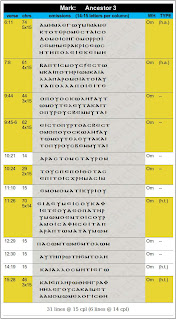Accordingly, Hort essentially elevated one rule to paramount importance and universal application:
This rule was originally a secondary rule proposed by Griesbach (1805) and meant only for cases where it was likely that a deliberate insertion had in fact been made. Griesbach's orignal rule had a long series of exceptions and counter-cases attached. But based on his own assessment of the value of Aleph and B (they were the oldest known manuscripts at the time), Hort judged that virtually all omissions were original, and all additions were spurious."Prefer the shortest reading."
 |
| Click to Enlarge, backbutton to return |
Hort's judgment is now known to be a gross mis-diagnosis of the case. Many studies of scribal habits and key manuscripts have shown that scribes tended to accidentally omit material quite often, about 4 to 10 times as often as they added material (see our links page for excerpts from these studies). We have found between 50 and 70 likely cases of accidental omission due to homoeoteleuton, and have documented them here.
On the other hand, the remaining 2/3 of omissions followed by Hort and modern critical editions are now also under serious suspicion. Scribes also often skipped lines even when there were no extenuating circumstances, such as a similar line-ending or beginning. Blunders are possible at any time, and many must have occurred in copying. These accidental omissions would be even harder to detect and more persistent in the copying stream, because they lacked obvious homoeoteleuton/arcton features.
A comparison of all the other omissions in Mark found in Aleph and B show that they too are often multiples of the same line-lengths of already identified homoeoteleuton errors. This suggests that they too may have been omitted accidentally under the same circumstances, at the same time as their complimentary homoeoteleuton companions.
The following charts illustrate the situation clearly. They group the omissions in Mark shared by Aleph/B according to line-length, and propose an ancestor of appropriate layout behind the omissions. They include the known homoeoteleuton errors for comparison. Yellow coding indicates that an omission may alternately belong to an ancestor with a different line-width, since the text can be divided up several ways. The Green color-coding here indicates more confidence both in the identification as homoeoteleuton, and as to the proposed line-length in the master-copy. :
The overwhelming and numerous matches of line-length are strong evidence of an underlying master-copy with these widths. It so happens that these line-lengths correspond quite closely to formats known to be popular in the 3rd century:
 | |
| Click to Enlarge |
Although many of the omissions in the Aleph/B stream are relatively early, they are highly unlikely to be original. The currently popular conjecture that the nearest common ancestor for Aleph/B is a 2nd century text seems to be an exaggeration, motivated by a desire to legitimize the Aleph/B text itself. In fact the evidence points toward an early 3rd century origin for most of the omissions common to Aleph and B.
mr.scrivener








No comments:
Post a Comment